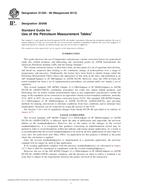We need your consent to use the individual data so that you can see information about your interests, among other things. Click "OK" to give your consent.
ASTM D972-02(2008)
Standard Test Method for Evaporation Loss of Lubricating Greases and Oils
STANDARD published on 1.5.2008
The information about the standard:
Designation standards: ASTM D972-02(2008)
Note: WITHDRAWN
Publication date standards: 1.5.2008
SKU: NS-39940
The number of pages: 4
Approximate weight : 12 g (0.03 lbs)
Country: American technical standard
Category: Technical standards ASTM
The category - similar standards:
Annotation of standard text ASTM D972-02(2008) :
Keywords:
evaporation, grease, oil, oil bath, rotameter, volatiles, Evaporation loss, Lubricating grease, Lubricating oils, Oil baths, Rotameter applications/analysis, Volatility--petroleum products, ICS Number Code 75.100 (Lubricants, industrial oils and related products)
Additional information
| Significance and Use | ||||||||
|
The loss of volatile materials from greases and oils can adversely effect the original performance characteristics of a lubricant and therefore could be a significant factor in evaluating a lubricant for a specific use. Such volatiles can also be considered contaminants in the environment in which the lubricant is to be used. Correlation between results from this test method and service performance has not been established. The test can be run at any agreed upon temperature between 100 and 150°C (210 to 300°F). Note 1—The specified flow of air, 2.58 ± 0.02 g/min, (2 L/min at standard temperature and pressure), assumes dry air. It is not known that the original work involved dry air but it has since been shown that this can be a factor in reproducibility and should be addressed. A dew point of less than 10°C at standard temperature and pressure will be satisfactory. Note 2—To determine evaporation loss at temperatures above 150°C (300°F), see Test Methods D 2595. |
||||||||
| 1. Scope | ||||||||
|
1.1 This test method covers the determination of the loss in mass by evaporation of lubricating greases and oils for applications where evaporation loss is a factor. Evaporation loss data can be obtained at any temperature in the range from 100 to 150°C (210 to 300°F). 1.2 The values stated in SI units are to be regarded as standard. The values in given in parentheses are for information only. 1.3 This standard does not purport to address all of the safety concerns, if any, associated with its use. It is the responsibility of the user of this standard to establish appropriate safety and health practices and determine the applicability of regulatory limitations prior to use. |
||||||||
| 2. Referenced Documents | ||||||||
|
Similar standards:
Historical
1.10.2013
Historical
1.12.2012
Historical
1.5.2010
Historical
1.5.2008
Historical
1.5.2011
Historical
1.1.2014
We recommend:
Technical standards updating
Do you want to make sure you use only the valid technical standards?
We can offer you a solution which will provide you a monthly overview concerning the updating of standards which you use.
Would you like to know more? Look at this page.



 ASTM D1250-08(2013)..
ASTM D1250-08(2013).. ASTM D1264-12
ASTM D1264-12 ASTM D1403-10
ASTM D1403-10 ASTM D1404/D1404M-99..
ASTM D1404/D1404M-99.. ASTM D1478-11
ASTM D1478-11 ASTM D1662-08(2014)..
ASTM D1662-08(2014)..
 Cookies
Cookies
